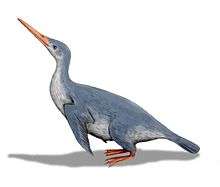Waimanu
Waimanu is a genus of early penguin which lived during the Paleocene soon after the Cretaceous–Paleogene extinction event. Its discovery helped support the idea that the radiation of the Neoaves (including most modern birds) either took place before the extinction of the non-avian dinosaurs or extremely rapidly immediately after. DNA-studies seem to indicate the latter.[1] While it was a very early member of the Sphenisciformes (the order that included modern penguins), Waimanu was already flightless like all modern penguins, with wings specialized for wing-propelled diving, though its wing bones do not yet show the extreme specializations modern penguins have for an aquatic lifestyle. It may have resembled a flightless loon in body shape, and possibly the great auk in its manner of locomotion. Both DNA sequence analyses and anatomy argue for a close relationship between penguins and loons, with penguins being specialized for wing-propelled diving, and loons for foot-propelled diving.
| Waimanu | |
|---|---|
 | |
| Scientific classification | |
| Kingdom: | Animalia |
| Phylum: | Chordata |
| Class: | Aves |
| Order: | Sphenisciformes |
| Genus: | †Waimanu Slack et al. 2006 |
| Type species | |
| †Waimanu manneringi | |
The Waimanu (from the Māori wai for "water" and manu for "bird") was discovered in the Waipara Greensand near the Waipara River, in Canterbury, New Zealand, in 1980. One species is known, Waimanu manneringi from the Middle Paleocene about 60 million years ago (mya).[2] A second species, Waimanu tuatahi, was moved to Muriwaimanu in 2018.[3]
References
- Hackett, S. J.; et al. (2008). "A Phylogenomic Study of Birds Reveals Their Evolutionary History". Science. 320 (5884): 1763–1768. doi:10.1126/science.1157704. PMID 18583609.
- Slack, K. E.; et al. (2006). "Early Penguin Fossils, plus Mitochondrial Genomes, Calibrate Avian Evolution". Molecular Biology and Evolution. 23 (6): 1144–1155. doi:10.1093/molbev/msj124. PMID 16533822.CS1 maint: ref=harv (link)
- Gerald Mayr; Vanesa L. De Pietri; Leigh Love; Al A. Mannering; R. Paul Scofield (2018). "A well-preserved new mid-Paleocene penguin (Aves, Sphenisciformes) from the Waipara Greensand in New Zealand". Journal of Vertebrate Paleontology. Online edition: e1398169. doi:10.1080/02724634.2017.1398169.